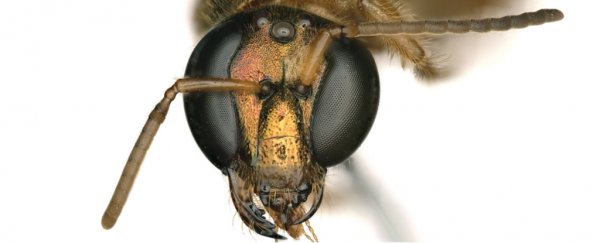Broadly speaking, animals tend to be sexually dimorphic. You have males, with small gametes, and females, with large gametes, both of which are required for sexual reproduction. Every now and again, though, nature throws a curveball - producing an organism that's a combination of both sexes, divided straight down the middle.
This condition is known as gynandromorphism, and scientists have just found the first known gynandromorphic individual of its species in a nocturnal bee native to Central and South America, Megalopta amoenae.
On its left side, the bee is physiologically male. It has a small, dainty mandible, a long antenna, and a thin, delicate hind leg with fewer bristles. The right side has female characteristics - a shorter antenna, a pronounced, toothed mandible, and a thick, hairy hind leg.
It's a known phenomenon - gynandromorphs have been found in at least 140 bee species, as well as butterflies, birds and crustaceans (but virtually unknown in mammals). In bees at least, it's usually only seen after the insect is already dead, and in a museum.
In this case, researchers led by entomologist Erin Krichilsky of Cornell University were conducting a study on circadian rhythms in M. amoenae, and were working with living bees from the forest of Barro Colorado Island in Panama at the Smithsonian Tropical Research Institute.
This was a stroke of luck - because studying gynandromorphic bees that are still alive could help us learn a lot about these fascinating insects.
 (Krichilsky et al., J. Hymenopt. Res., 2020)
(Krichilsky et al., J. Hymenopt. Res., 2020)
"This phenomenon [gynandromorphism] may offer insight into the evolution of specialised morphological traits, such as male-like morphology of female brood-parasitic bee lineages, the modified morphology of social insect castes, and novel methods of reproduction," the researchers wrote in their paper.
There are aspects of bee gynandromorphism we are starting to understand very well. A 2018 study, for instance, was able to shed some light on how they come to exist in honeybees.
Sex determination in Hymenoptera - the order of insects that includes bees, ants and wasps - is really peculiar. If an egg is fertilised? You get a female. An unfertilised egg produces a male. But, as the 2018 research found, if sperm from a second and even third individual enters an egg that's already fertilised - a female embryo - it can divide to produce male tissue, resulting in a gynandromorph.
A handful of studies have focused on different areas of behaviour in live gynandromorphic bees - nesting behaviour and courtship. Since this team was already studying circadian rhythms - which synchronise a species' behaviour and interactions with the external environment - they decided to see if and how circadian rhythms differed in their gynandromorphic individual.
They tracked their bee over four days, and found that it tends to wake a little earlier than both male and female bees. However, its highest-intensity periods of activity most closely resembled female behaviour.
In and of itself, this can't be taken to mean much. It could indicate that the brains of gynandromorphic bees have mixed sex-specific signalling, and they are unable to integrate the two. Or it could be that the bee is just a bit of an individual, gynandromorphism aside.
But it does provide a first datapoint, a position to start from if other living gynandromorphic bees are found and can be studied.
"It should be noted that ours was only a single sample," the researchers wrote in their paper.
"More studies need to be done to better understand if there is a difference in circadian rhythm based on sex in this species, and to distinguish what the deviant activity pattern of the gynandromorph results from."
The research has been published in the Journal of Hymenoptera Research.
